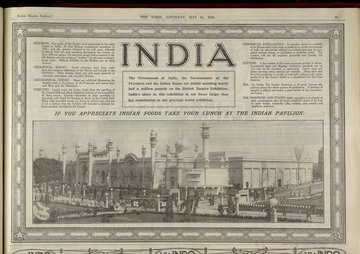
British Empire Exhibition, 1924
‐
An exhibition of industry across the British empire
Place of event
Wembley
About
The British Empire Exhibition was opened on St George’s Day, 23 April 1924, by King Edward V and Queen Mary at the Empire Stadium. The idea for an exhibition of industry across the empire was under consideration from early on in the twentieth century; however, the idea was abandoned when the Russo-Japanese war broke out in 1904. In 1913 the idea was resurrected by Lord Strathcona, but the outbreak of the First World War meant that the exhibition was delayed for a second time. In 1919 the proposition was reconsidered at a lunch at the Empire Club which was attended by Prime Ministers and High Commissioners from across the empire, who agreed on a proposed date of 1921. With the passing of the British Empire Exhibition (Guarantee) Act, the government became joint guarantor, ending up funding around 50 per cent of the £2.2 million raised to stage the exhibition. 1923 was proposed as the new opening date, although this was later postponed to 1924.
The organizers pursued four main objectives with the exhibition. They wanted to alert the public to the fact that in the exploitation of raw materials of the empire, new sources of wealth could be produced; to foster inter-imperial trade; to open new world markets for Dominion and British products; and to foster interaction between the different cultures and people of the empire by juxtaposing Britain’s industrial prowess with the diverse products of the Dominions and colonies. The location for the exhibition was Wembley Park, as it was regarded as one of the most easily accessible areas of London, both from the suburbs and from the rest of the country, with two mainline stations and a new station inside the exhibition grounds. A vast infrastructure project was also proposed, leading to the widening of approach roads from central London to the exhibition. The exhibition covered an area of more than 216 acres and in the two years it was open attracted over 20 million visitors.
The exhibition was open for six months in 1924 and reopened in 1925, and showcased produce and manufactured goods, arts and crafts as well as historical artefacts from the Indian Empire and each of the Dominions, as well as Britain’s African and Caribbean colonies. The exhibition was also accompanied by a cultural programme and a series of conferences. Britain focused on its textiles, chemicals and engineering and was keen to emphasize its central role in ensuring progress for the whole of the empire. The Ceylon Pavilion, modelled on the Temple of the Tooth in Kandy, displayed valuable collections of jewellery and gemstones. Built by architects Charles Allem and Sons, the India Pavilion was modelled on the Jama Masjid in Delhi and the Taj Mahal in Agra. The white building was divided into twenty-seven courts, each dedicated to the exhibition of products from one of the twenty-seven Indian provinces. It was one of the few pavilions where food was served. It also hosted an exhibition on Indian art curated by the India Society with the involvement of William Rothenstein, who made available over twenty-three paintings – only the India Office lent more. The Fine Art Committee for the India section at the exhibition included Austin Kendall, Stanley Clarke, Sir Hercule Read (President of the India Society), William Rothenstein, William Foster and Laurence Binyon. The India Society also held a conference at the Exhibition on 2 June 1924.
When the exhibition closed in October 1925, it had made a loss of £1.5 million.
Laurence Binyon, Mukul Dey, William Foster, George Ambrose Lloyd, Thomas Sturge Moore, Samuel Fyzee Rahamin, William Rothenstein, Abanindranath Tagore.
King George V (Patron), Edward, Prince of Wales (President).
Board: James Allen, Traverse Clarke, Charles McLeod, Henry MacMahon, James Stevenson.
The British Empire Exhibition Wembley 1924 – Fiftieth Anniversary (Wembley: Wembley History Society, 1974)
Grant Cook, Marjorie and Fox, Frank, The British Empire Exhibition, 1924: Official Guide (London: Fleetway Press, 1924)
Greenhalgh, Paul, Ephemeral Vistas: The Expositions Universelles, Great Exhibitions and World’s Fairs, 1851–1939 (Manchester: Manchester University Press, 1988)
Hughes, Deborah, 'Kenya, India and the British Empire Exhibition of 1924', Race and Class, 47.4 (April–June 2006), pp. 66–85
Knight, Donald R. and Sabey, Alan D., The Lion Roars at Wembley: British Empire Exhibition 60th Anniversary, 1924–1925 (New Barnet: D. R. Knight, 1984)
Mitter, Partha, The Triumph of Modernism: India's Artists and the Avant-Garde 1922–1947 (London: Reaktion, 2007)
Moore, Harras, The Marlborough Pocket Guide to the British Empire Exhibition at Wembley, 1924 (London: Marlborough Printing Company, 1924)
Mss Eur F 147, India Society papers, Asian and African Studies Reading Room, British Library, St Pancras
For image and copyright details, please click "More Information" in the Viewer.
Image credit
Indian Pavilion advert from British Empire Exhibition; The Times, 24 May 1924, p. iii (British Empire Section), Courtesy of British Library Board
